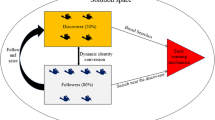Abstract
We propose multi-objective social learning pigeon-inspired optimization (MSLPIO) and apply it to obstacle avoidance for unmanned aerial vehicle (UAV) formation. In the algorithm, each pigeon learns from the better pigeon but not necessarily the global best one in the update process. A social learning factor is added to the map and compass operator and the landmark operator. In addition, a dimension-dependent parameter setting method is adopted to improve the blindness of parameter setting. We simulate the flight process of five UAVs in a complex obstacle environment. Results verify the effectiveness of the proposed method. MSLPIO has better convergence performance compared with the improved multi-objective pigeon-inspired optimization and the improved non-dominated sorting genetic algorithm.
Similar content being viewed by others
References
Alonso-Mora J, Montijano E, Schwager M, et al., 2016. Distributed multi-robot formation control among obstacles: a geometric and optimization approach with consensus. Proc IEEE Int Conf on Robotics and Automation, p.5356-5363. https://doi.org/10.1109/icra.2016.7487747
Benjamin MR, Defilippo M, Robinette P, et al., 2019. Obstacle avoidance using multiobjective optimization and a dynamic obstacle manager. IEEE J Ocean Eng, 44(2):331–342. https://doi.org/10.1109/JOE.2019.2896504
Biro D, Sasaki T, Portugal SJ, 2016. Bringing a time-depth perspective to collective animal behaviour. Trends Ecol Evol, 31(7):550–562. https://doi.org/10.1016/j.tree.2016.03.018
Cheng R, Jin YC, 2015. A social learning particle swarm optimization algorithm for scalable optimization. Inform Sci, 291:43–60. https://doi.org/10.1016/j.ins.2014.08.039
Di B, Zhou R, Duan HB, 2015. Potential field based receding horizon motion planning for centrality-aware multiple UAV cooperative surveillance. Aerosp Sci Technol, 46:386–397. https://doi.org/10.1016/j.ast.2015.08.006
Duan HB, Qiao PX, 2014. Pigeon-inspired optimization: a new swarm intelligence optimizer for air robot path planning. Int J Intell Comput Cybern, 7(1):24–37. https://doi.org/10.1108/IJICC-02-2014-0005
Faisal M, Hedjar R, Al Sulaiman M, et al., 2013. Fuzzy logic navigation and obstacle avoidance by a mobile robot in an unknown dynamic environment. Int J Adv Robot Syst, 10(1):37. https://doi.org/10.5772/54427
Ferri G, Munafò A, LePage KD, 2018. An autonomous underwater vehicle data-driven control strategy for target tracking. IEEE J Ocean Eng, 43(2):323–343. https://doi.org/10.1109/JOE.2018.2797558
Floreano D, Wood RJ, 2015. Science, technology and the future of small autonomous drones. Nature, 521(7553):460–466. https://doi.org/10.1038/nature14542
Forestiero A, 2017. Bio-inspired algorithm for outliers detection. Multimed Tools Appl, 76(24):25659–25677. https://doi.org/10.1007/s11042-017-4443-1
Guo X, Lu JQ, Alsaedi A, et al., 2018. Bipartite consensus for multi-agent systems with antagonistic interactions and communication delays. Phys A, 495:488–497. https://doi.org/10.1016/j.physa.2017.12.078
Ho HS, Do CS, 2017. Multi-agent based design of autonomous UAVs for both flocking and formation flight. J Adv Korea Navig Technol, 21(6):521–528. https://doi.org/10.12673/jant.2017.21.6.521
Kownacki C, Ambroziak L, 2017. Local and asymmetrical potential field approach to leader tracking problem in rigid formations of fixed-wing UAVs. Aerosp Sci Technol, 68:465–474. https://doi.org/10.1016/j.ast.2017.05.040
Luo QN, Duan HB, 2017. Distributed UAV flocking control based on homing pigeon hierarchical strategies. Aerosp Sci Technol, 70:257–264. https://doi.org/10.1016/j.ast.2017.08.010
Mohanty PK, Parhi DR, 2012. Path generation and obstacle avoidance of an autonomous mobile robot using intelligent hybrid controller. Proc 3rd Int Conf on Swarm, Evolutionary, and Memetic Computing, p.240-247. https://doi.org/10.1007/978-3-642-35380-2_29
Molinos EJ, Llamazares Á, Ocana M, 2019. Dynamic window based approaches for avoiding obstacles in moving. Robot Auton Syst, 118:112–130. https://doi.org/10.1016/j.robot.2019.05.003
Paul AK, Shill PC, 2018. New automatic fuzzy relational clustering algorithms using multi-objective NSGA-II. Inform Sci, 448–449:112–133. https://doi.org/10.1016/j.ins.2018.03.025
Qiu HX, Duan HB, 2017a. Multiple UAV distributed close formation control based on in-flight leadership hierarchies of pigeon flocks. Aerosp Sci Technol, 70:471–486. https://doi.org/10.1016/j.ast.2017.08.030
Qiu HX, Duan HB, 2017b. Pigeon interaction mode switch-based UAV distributed flocking control under obstacle environments. ISA Trans, 71:93–102. https://doi.org/10.1016/j.isatra.2017.06.016
Qiu HX, Duan HB, 2020. A multi-objective pigeon-inspired optimization approach to UAV distributed flocking among obstacles. Inform Sci, 509:515–529. https://doi.org/10.1016/j.ins.2018.06.061
Sun F, Turkoglu K, 2017. Distributed real-time non-linear receding horizon control methodology for multi-agent consensus problems. Aerosp Sci Technol, 63:82–90. https://doi.org/10.1016/j.ast.2016.12.018
Wang J, Ahn IS, Lu YF, et al., 2017. A distributed estimation algorithm for collective behaviors in multiagent systems with applications to unicycle agents. Int J Contr Autom Syst, 15(6):2829–2839. https://doi.org/10.1007/s12555-016-0015-9
Wu ST, 2013. Flight Control System (2nd Ed.). Beihang University Press, Beijing, China (in Chinese).
Yan MD, Zhu X, Zhang XX, et al., 2017. Consensus-based three-dimensional multi-UAV formation control strategy with high precision. Front Inform Technol Electron Eng, 18(7):968–977. https://doi.org/10.1631/FITEE.1600004
Zhang T, Li Q, Zhang CS, et al., 2017. Current trends in the development of intelligent unmanned autonomous systems. Front Inform Technol Electron Eng, 18(1):68–85. https://doi.org/10.1631/FITEE.1601650
Zhao WW, Chu HR, Zhang MY, et al., 2019. Flocking control of fixed-wing UAVs with cooperative obstacle avoidance capability. IEEE Access, 7:17798–17808. https://doi.org/10.1109/ACCESS.2019.2895643
Author information
Authors and Affiliations
Contributions
Hai-bin DUAN and Wan-ying RUAN designed the research. Wan-ying RUAN processed the data and drafted the manuscript. Hai-bin DUAN helped organize and check the manuscript. Wan-ying RUAN revised and finalized the paper.
Corresponding author
Ethics declarations
Wan-ying RUAN and Hai-bin DUAN declare that they have no conflict of interest.
Additional information
Project supported by the Science and Technology Innovation 2030-Key Project of “New Generation Artificial Intelligence,” China (No. 018AAA0102303), the National Natural Science Foundation of China (Nos. 91948204, 91648205, U1913602, and U19B2033), and the Aeronautical Foundation of China (No. 20185851022)
Rights and permissions
About this article
Cite this article
Ruan, Wy., Duan, Hb. Multi-UAV obstacle avoidance control via multi-objective social learning pigeon-inspired optimization. Front Inform Technol Electron Eng 21, 740–748 (2020). https://doi.org/10.1631/FITEE.2000066
Received:
Accepted:
Published:
Issue Date:
DOI: https://doi.org/10.1631/FITEE.2000066
Key words
- Unmanned aerial vehicle (UAV)
- Obstacle avoidance
- Pigeon-inspired optimization
- Multi-objective social learning pigeon-inspired optimization (MSLPIO)




